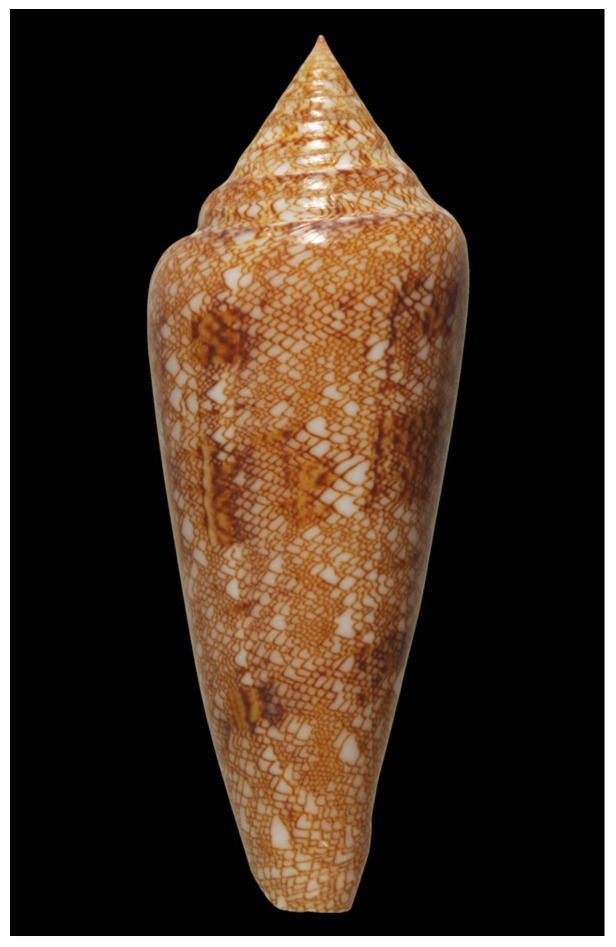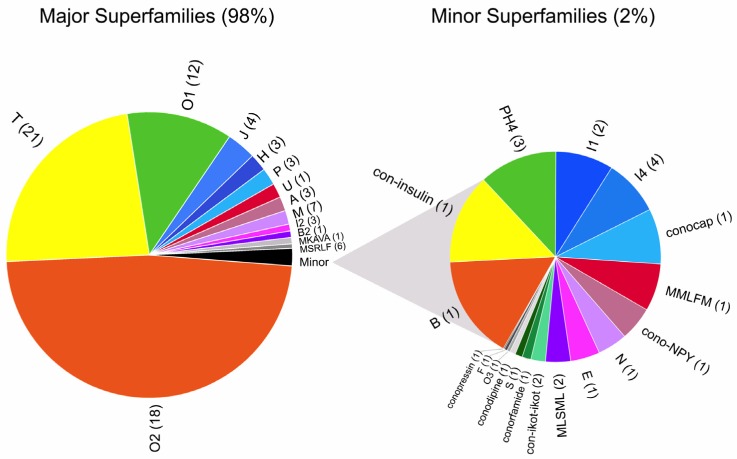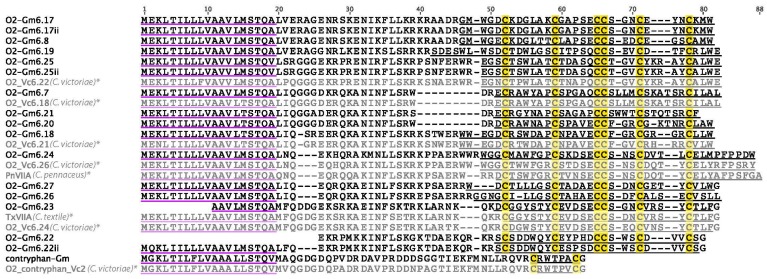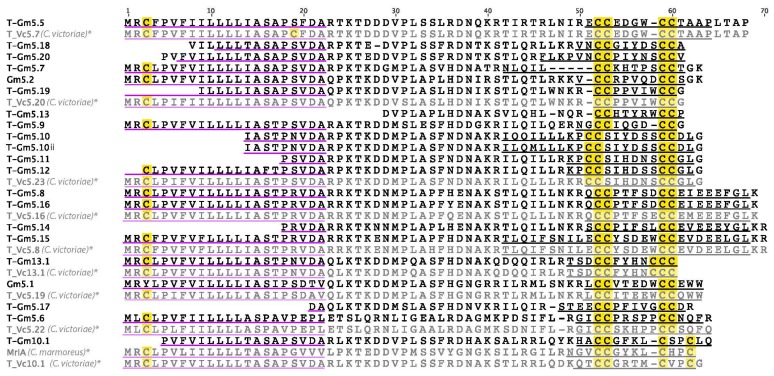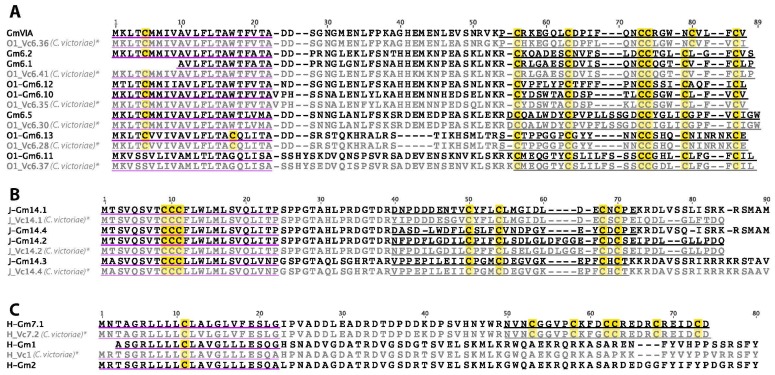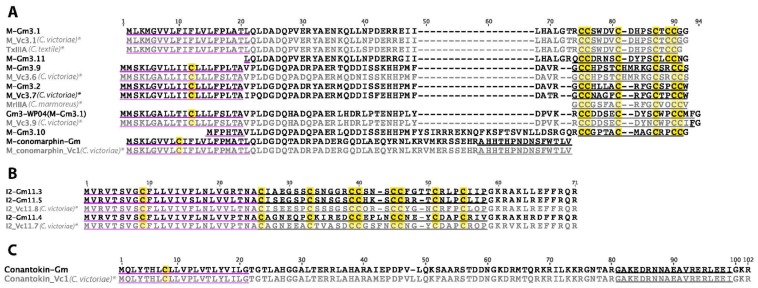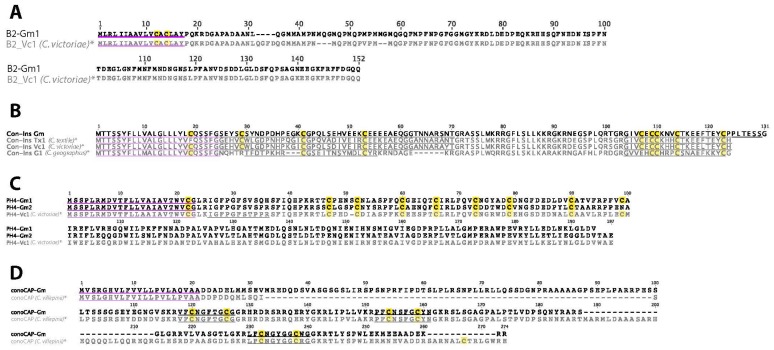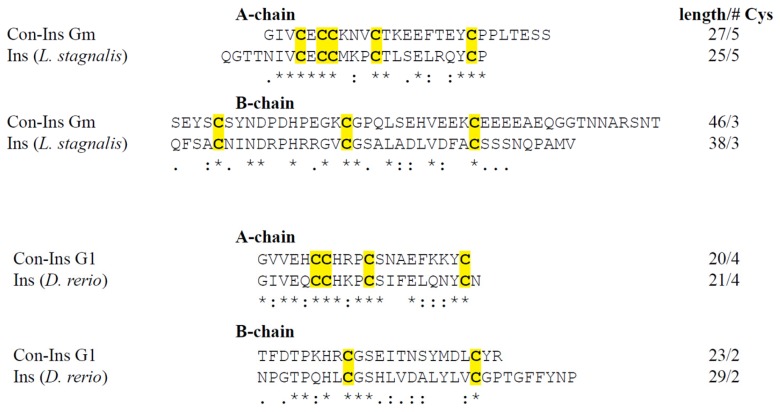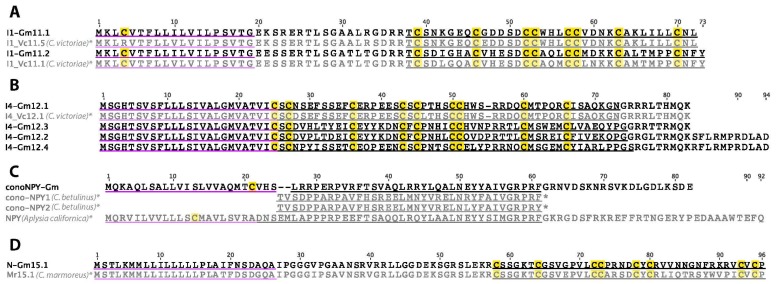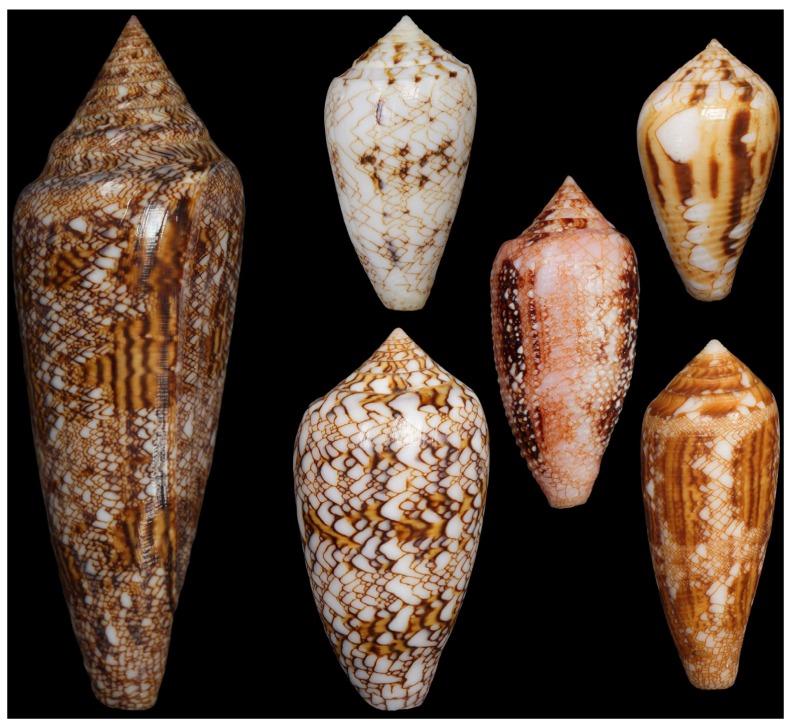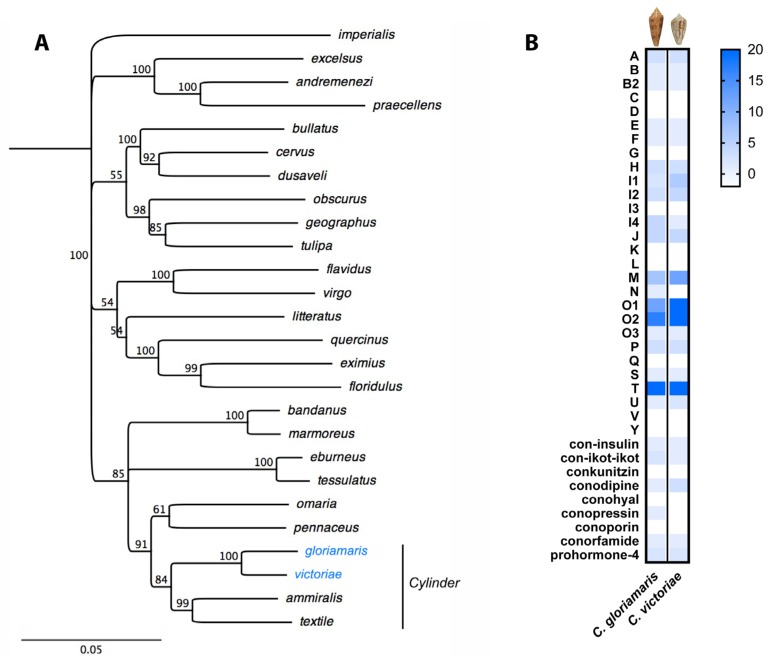Abstract
The marine cone snail Conus gloriamaris is an iconic species. For over two centuries, its shell was one of the most prized and valuable natural history objects in the world. Today, cone snails have attracted attention for their remarkable venom components. Many conotoxins are proving valuable as research tools, drug leads, and drugs. In this article, we present the venom gland transcriptome of C. gloriamaris, revealing this species’ conotoxin repertoire. More than 100 conotoxin sequences were identified, representing a valuable resource for future drug discovery efforts.
Keywords: venom, conotoxin, Conus, cone snail, Conus gloriamaris
1. Introduction
For many years, the shell of the Glory of the Sea cone snail, Conus gloriamaris, was one of the most prized and valuable natural history objects in the world [1,2]. The shell is indeed remarkably beautiful (Figure 1), but it is perhaps its rarity that contributed most to its fame—for over two centuries, C. gloriamaris was known from only half a dozen specimens.
Figure 1.
The shell of Conus gloriamaris. At one time, this was among the most prized natural history objects in the world.
In 1837, Hugh Cuming, a British shell collector, found two live specimens on a reef on the island of Bohol, the Philippines [2]. Soon after, however, it would be reported that this reef, the only known location at which C. gloriamaris had been found alive, had been destroyed by an earthquake. Rumours followed that this already rare species had now been driven to extinction, and produced the obvious effect of making the few known specimens even more desirable. As recently as 1957, the number of known specimens was still only at two dozen. However, this would change as collectors entered into the waters of New Guinea and in 1969, a pair of SCUBA divers discovered over a hundred live specimens at Guadalcanal in the Solomon Islands [3].
Although still not considered to be abundant, C. gloriamaris is in fact reasonably widespread across the Indo-Pacific. It has been found between 5 and 300 m, but is rarely encountered in shallow water (above 100 m) [4], explaining its historical rarity. Nevertheless, it remains probably the single most famous seashell, and because of its beauty and historic significance, still attracts high prices from collectors.
Today, cone snails are attracting attention for an additional reason, the remarkable biomedical potential of their venom components. Each one of the ~750 species of the genus Conus is venomous (number of extant species according to WoRMS: http://www.marinespecies.org/). They use their venom for prey capture and defense [5]. Some species prey on fish, whilst others prey on marine worms or molluscs. C. gloriamaris is believed to be a mollusc-hunter [4]. Their venoms are complex mixtures typically containing more than 100 bioactive peptides (known as conotoxins). Furthermore, each species of Conus is thought to harbour an almost unique repertoire of conotoxins. Many conotoxins have unmatched potency and selectivity profiles at their respective molecular targets [6]. Additionally, while only a minute fraction of the estimated total number of conotoxins has been investigated to date, several have already proven valuable as research tools, drug leads, and drugs. ω-MVIIA, a conotoxin from the venom of Conus magus, is used for the treatment of chronic pain [7], while several others are under development for the treatment of various pathologies [8], including epilepsy, neuropathic pain, and diabetes.
Conotoxins are produced, by the cone snail, in a specialized venom gland. Conotoxin transcripts are ribosomally-translated into precursor peptides that undergo folding and post-translational processing before being secreted into the lumen of the venom gland [9]. In general, conotoxin precursor peptides are characterized by an N-terminal signal peptide followed by a propeptide region, and, encoded at the C-terminus, a single copy of the bioactive mature toxin.
Recent advances in high throughput ‘next-generation’ sequencing have made it possible to sequence the entire transcriptome of a tissue in a rapid and cost-effective manner. The application of this technology to the venom glands of Conus offers an avenue to acquiring a comprehensive picture of a species’ conotoxin repertoire [10,11,12,13].
The venom of C. gloriamaris has yet to be comprehensively studied. Only 10 conotoxin sequences have so far been reported from this species [14] and only two conotoxins (Gm9a and GmVIA) have been functionally characterised [15,16]. In this article, we present the venom gland transcriptome of C. gloriamaris, revealing the venom repertoire of this iconic species.
2. Results
Sequencing generated from C. gloriamaris whole venom gland RNA yielded a total of 42,602,912 demultiplexed raw reads (40,363,512 following adapter-trimming and quality-trimming/filtering). Using Trinity [17], 16,353 transcripts were assembled with an E90 of 238 (the number of transcripts that are supported by 90% of the expression data). Transcripts annotated as conotoxin precursors made up ~70% of the total expression data, as well as the bulk of the most highly expressed transcripts, i.e., all of the top 60 annotated transcripts were conotoxin precursors.
Conotoxin precursors can be grouped into gene families (or superfamilies), based on their signal peptide sequence identity [18]. A total of 31 distinct conotoxin gene families were identified in C. gloriamaris. Not all toxin gene families were expressed at equal levels. In fact, 95% of conotoxin expression was derived from just nine gene families (O2, T, O1, J, H, P, U, A, and M; from highest to lowest) (Figure 2).
Figure 2.
Distribution of toxin gene families in C. gloriamaris. Conotoxin expression is dominated by only a few conotoxin gene families. Values represent transcripts per million transcripts (TPM) counts obtained for all sequences belonging to the gene family. The number of individual sequences per toxin gene family is provided in parenthesis.
From the 31 toxin gene families, a total of 108 individual conotoxin transcripts were identified. Again, there are substantial differences in the number of individual toxins per gene family. Almost all of the toxin gene families identified were represented by three or fewer individual toxins. Only five toxin gene families were represented by more than four individual conotoxin transcripts (O2, T, O1, M, and MSRLF) (Figure 2).
2.1. O2-Superfamily
In C. gloriamaris, the O2-superfamily is the single most-highly expressed toxin gene family, accounting for close to half of the total conotoxin expression. It is also a diverse superfamily: 17 individual O2-superfamily conotoxins were detected (Figure 3). Of these, 16 have the typical type VI/VII cysteine framework (C-C-CC-C-C) and one belongs to a subclass known as contryphans. Of the two O2-superfamily conotoxins characterized so far (TxVIIA and PnVIIA), both appeared to be mollusc-specific in activity, producing strong paralytic effects in molluscs, but with no paralytic effects on arthropods or vertebrates [19,20]. Notably, for a number of the C. gloriamaris O2-superfamily conotoxins identified here, an identical or nearly identical sequence was previously described in Conus victoriae [13]. C. victoriae is a closely-related species belonging to the same subgenus (Cylinder), endemic to the coast of North-Western Australia. As is discussed below, a striking similarity to C. victoriae is observed for almost all of the toxin families identified.
Figure 3.
Sequence alignment of C. gloriamaris O2-superfamily precursor sequences. Precursor sequences of O2_Vc6.22, O2_Vc6.18, O2_Vc6.21, O2_Vc6.26, O2_Vc6.24, O2_contryphan_Vc2 [13], PnVIIA [20], and TxVIIA [19] are shown for comparison in grey and marked with *; Cys, yellow; Signal peptides are underlined in purple and predicted mature peptides are underlined in black/grey. This color scheme is used in all subsequent figures.
2.2. T-Superfamily
In C. gloriamaris, the T-superfamily is the second most highly expressed toxin gene family, making up 22% of the total conotoxin expression. It is also the most diverse: 21 individual sequences were identified (Figure 4), including the previously reported Gm5.1 and Gm5.2 [21]. Nineteen of these had a type V cysteine framework (CC-CC), one a type XIII framework, and one a type I/X cysteine framework (CC-C-C). Several molecular targets, including presynaptic calcium channels [22], TTX-sensitive sodium channels [23], and somatostatin receptors [24], have been reported for conotoxins of the former subclass, while the toxins of the latter subclass are norepinephrine transporter inhibitors [25]. For several of the C. gloriamaris T-superfamily conotoxins identified here, an identical or nearly identical sequence was previously described in C. victoriae.
Figure 4.
C. gloriamaris T-superfamily precursor sequences. *, precursor sequences of T_Vc5.7, T_Vc5.20, T_Vc5.23, T_Vc5.16, T_Vc5.8, T_Vc13.1, T_Vc5.19, T_Vc5.22, T_Vc10.1 [13], and MrIA [26] are shown for comparison.
2.3. O1-Superfamily
A total of 12 O1-superfamily conotoxin precursors were identified in C. gloriamaris (Figure 5A), including four sequences previously reported from this species (Gm6.1, Gm6.2, Gm6.5 [27], and GmVIA [28]). GmVIA is a δ-conotoxin, which delays the inactivation of voltage-gated sodium channels and produced convulsions in molluscs [28]. All O1-superfamily precursors from C. gloriamaris encode mature peptides with the typical type VI/VII cysteine framework, and all, except one low-expressed transcript, fit into the same δ/μ functional subclass as GmVIA. Again, for several of the C. gloriamaris O1-superfamily conotoxins identified here, an identical or close match was previously described in C. victoriae.
Figure 5.
(A) C. gloriamaris O1-superfamily; (B) J-superfamily; (C) H-superfamily precursor sequences. *, precursor sequences of O1_Vc6.36, O1_Vc6.41, O1_Vc6.35, O1_Vc6.30, O1_Vc6.28, O1_Vc6.37, J_Vc14.1, J_Vc14.2, J_Vc14.4, H_Vc7.2, and H_Vc1 [13] are shown for comparison.
2.4. J-Superfamily
Four J-superfamily conotoxins were identified in the venom gland transcriptome of C. gloriamaris (Figure 5B). They are similar to the sequence previously identified in C. victoriae [13], but differ from the previously characterised J-superfamily conotoxin pl14a, which produces excitatory symptoms (shaking, barrel-rolling, and seizures) in mice on intracranial injection and was shown to be an inhibitor of the voltage-gated potassium channel subtype Kv1.6 [29].
2.5. H-Superfamily
Both cysteine-rich (one), and cysteine-poor (two) H-superfamily conotoxins were identified (Figure 5C). The cysteine-poor conotoxins are both closely related to H-Vc1, previously identified in C. victoriae, while the predicted mature peptide of the cysteine-rich H-Gm7.1, differs only by a single residue from that of Vc7.2 from C. victoriae. The biological function is yet to be reported for any H-superfamily conotoxin.
2.6. P-Superfamily
Three P-superfamily transcripts were identified in the venom gland transcriptome of C. gloriamaris (Figure 6A). One of these is Gm9a (previously identified from C. gloriamaris [15]) and another appears to be an allelic variant of this sequence, differing by only a single synonymous substitution. Gm9a elicited hyperactivity and spasticity in mice on intracranial injection. The third precursor, P-Gm14.1, encodes a 30 residue mature peptide cysteine framework XIV (C-C-C-C). It is closely related to Vc14.5 from C. victoriae, differing in its predicted mature peptide by only three residues.
Figure 6.
(A) C. gloriamaris P-superfamily; (B) U-superfamily; (C) A-superfamily precursor sequences. *, precursor sequences of P_Vc9.2, P_Vc14.5, U_Vc7.3, Vc22.1 [13], Tx1 [30], Vc1.1 [31], and the textile convulsant mature peptide [32], are shown for comparison.
2.7. U-Superfamily
A single precursor sequence belonging to the U-superfamily was identified in C. gloriamaris (Figure 6B). The predicted mature peptide is identical to the previously described Vc7.3 from C. victoriae and differs by one residue from the “Textile convulsant peptide” from C. textile, which produces convulsions when injected intracranially in mice [32].
2.8. A-Superfamily
Three A-superfamily conotoxin precursors were identified in the C. gloriamaris venom gland transcriptome (Figure 6C). The most highly expressed A-superfamily sequence in C. gloriamaris was Gm1.1. The predicted mature peptide is similar to several previously described α-conotoxins and is likely to also be an inhibitor of neuronal subtypes of nicotinic acetylcholine receptors. Gm22.1 belongs to an unusual subclass that was previously described in C. victoriae [13]. A comparison of Gm22.1 with Vc22.1 is shown in Figure 6C. While there are minor differences in the signal and propeptide, the predicted mature peptides are identical between species. The third precursor shares the A-superfamily signal sequence, but appears to encode an unusually large (87 residues) mature peptide with 12 cysteines, and is unrelated to any previously described sequence.
2.9. M-Superfamily
In C. gloriamaris, seven M-superfamily conotoxins were detected (Figure 7A), including the previously reported Gm3-WP04 (GenBank: JF510902.1). All, bar one, belong to the “mini-M” subclass [33], which produce excitatory symptoms when injected intracranially in mice, but for which a general molecular target is yet to be defined. The remaining sequence encodes a cysteine-free conomarphin.
Figure 7.
(A) C. gloriamaris M-superfamily; (B) I2-superfamily; (C) B-superfamily precursor sequences. *, precursor sequences of M_Vc3.1, M_Vc3.6, M_Vc3.9, M_conomarphin_Vc1, I2_Vc11.8, I2_Vc11.7, conantokin_Vc1 [13], TxIIIA [34], and the mature peptide of MrIIIA [35] are shown for comparison.
2.10. I2-Superfamily
Three I2-superfamily conotoxins were identified in C. gloriamaris (Figure 7B). There are similarities to previously identified sequences, in particular those of C. victoriae, but there is little similarity to any of the I2-superfamily toxins with a known function (as potassium channel blockers [36,37,38]).
2.11. B2-Superfamily
A single B2-supefamily sequence was detected in C. gloriamaris (Figure 8A). The B2-“superfamily” refers to an unusual class of sequence that is found at a high frequency in the venom glands of all species of Conus examined [13]. The functional role of this class of sequences remains unclear.
Figure 8.
(A) C. gloriamaris B2-superfamil; (B) Con-insulin; (C) prohormone-4; (D) conoCAP precursor sequences. *, precursor sequences of B2_Vc1 [13], Con-Ins Tx1 [39], Con-Ins Vc1, PH4-Vc1 [40], and conoCAP [41] are shown for comparison.
2.12. B-Superfamily (Conantokins)
One conantokin was identified in the C. gloriamaris venom gland transcriptome (Figure 7C). Conantokins are cysteine-free peptides, some of which are antagonists of vertebrate N-methyl-D-aspartate receptor (NMDA) receptors [42]. Conantokin-Gm1 is very similar to the single conantokin sequence identified in C. victoriae. Minor differences are seen in the signal and propeptide, while the encoded mature peptides are identical between the two species.
2.13. Con-Insulin
A single venom insulin transcript was identified in C. gloriamaris (Figure 8B). Specialised insulins are a venom component of many species of Conus [39]. One of these, Con-Ins G1 from C. geographus, has been characterised, and binds to the vertebrate insulin receptor, inducing “insulin shock” in the fish prey.
The venom insulin from C. gloriamaris belongs to the same gene family as Con-Ins G1 [43]. The predicted signal sequences of both venom insulins are highly similar, a characteristic of secreted venom components that belong to the same gene family. However, the predicted mature insulins differ significantly. The insulin from C. gloriamaris is longer and has an additional interchain disulfide bond. These differences can readily be rationalized by comparing the two venom insulins with the endogenous insulins of the zebrafish and the snail Lymnaea stagnalis (Figure 9). The C. gloriamaris insulin has the same organization and a greater sequence similarity to the Lymnaea insulin, while Con-Ins G1, the insulin from C. geographus, shows a much greater similarity to the zebrafish hormone. C. geographus is a fish-hunting species, while C. gloriamaris is a snail hunter. Thus, in each case, the structure of the venom insulin appears to reflect a strong selection for efficacy in the distinct prey of each species.
Figure 9.
Similarity in cysteine arrangement, chain lengths, and amino acids between the A and B chains of Con-Ins Gm and an endogenous molluscan insulin, and Con-Ins G1 and an endogenous fish insulin. Comparative alignments of Con-Ins Gm and the giant pond snail Lymnaea stagnalis insulin 1 [Uniprot: P07223], and Con-Ins G1 from the venom of C. geographus and the zebrafish Danio rerio insulin [Uniprot: O73727]. Chain lengths and the cysteine number are shown following the sequence. Cysteines are highlighted in yellow. Post-translational modifications are omitted.
2.14. Prohormone-4
Two prohormone-4 precursors were identified in C. gloriamaris (Figure 8C). Prohormone-4 is a neuropeptide that was initially identified in the brain of the honeybee, Apis melifera, but was more recently identified as a venom component in some species of Conus [40].
A second class of prohormone-4-like precursors that do not appear to encode any mature peptide have been reported in all Conus examined to-date [40]. A transcript belonging to this class was also identified in C. gloriamaris.
2.15. I1-Superfamily
Two I1-superfamily conotoxins were identified in C. gloriamaris (Figure 10A). Closely-related sequences were previously reported in C. victoriae [13]. The predicted mature peptide of Gm11.2 differs by a single amino acid to that of I1-Vc11.5. The I1-superfamily conotoxins characterized so far produce excitatory symptoms in mice, and one, RXIA, produces these through the agonism of voltage-gated sodium channels [44].
Figure 10.
(A) C. gloriamaris I1-superfamily; (B) I4-superfamily; (C) cono-NPY; (D) N-superfamily precursor sequences. *, precursor sequences of I1_Vc11.5, I1_Vc11.1, I4_Vc12.1 [13], cono-NPY [45], and Mr15.1 [10] are shown for comparison.
2.16. I4-Superfamily
Four I4-superfamily precursors were identified in C. gloriamaris (Figure 10B). The predicted mature peptide of I4-Gm12.1 differs from that of the previously described I4_Vc12.1 [13], by only two residues. No function has yet been ascribed to any conotoxin belonging to the I4-superfamily.
2.17. ConoCAP
A conoCAP precursor was identified in the C. gloriamaris venom gland transcriptome (Figure 8D). ConoCAPs are short single disulphide-containing peptides identified in the venom of some worm-hunting cone snails, which reduce the heart rate and blood pressure (in vertebrates) [41]. In contrast to other Conus venom peptides, multiple conoCAPs are encoded on a single long neuropeptide-like precursor. The C. gloriamaris conoCAP precursor encodes three individual mature peptides.
2.18. Cono-NPY
Cono-NPY was the name given to two peptides previously isolated from the venom of the worm-hunter Conus betulinus because of their similarity to neuropeptide-Y [45]. Here, we report, in the venom gland transcriptome of C. gloriamaris, a precursor that encodes a mature peptide with a sequence similarity to the previously reported cono-NPY peptides (Figure 10C). High expression in the venom gland and a secretory signal peptide are consistent with the role of this peptide as a toxin in the venom of C. gloriamaris. Furthermore, preliminary investigations indicate that other mollusc-hunting cone snails share closely related precursors in their venoms (unpublished observation).
2.19. N-Superfamily
A single N-superfamily precursor, Gm15.1, was found in the venom gland transcriptome of C. gloriamaris (Figure 10D). It shows a high sequence similarity to Mr15.1, one of the sequences previously identified in C. marmoreus [10]. The biological function is yet to be reported for any conotoxin of the N-superfamily.
2.20. E-Superfamily
A single E-superfamily sequence was identified in C. gloriamaris (Figure 11A). The alignment of this sequence with that of C. victoriae reveals seven differences across the 90 residue precursor. No biological function has been reported for any conotoxin of this “superfamily”.
Figure 11.
(A) C. gloriamaris E-superfamily; (B) con-ikot-ikot; (C) conorfamide; (D) S-superfamily precursor sequences. *, precursor sequences of E_Vc1, S_Vc8.1 [13], con-ikot-ikot [46], and CNF_Vc1 [47] are shown for comparison.
2.21. Con-ikot-ikot
Two con-ikot-ikot precursor sequences were identified in C. gloriamaris (Figure 11B). Con-ikot-ikots are a class of conotoxin predominantly found in the venoms of fish-hunters. Con-ikot-ikot from Conus striatus inhibits AMPA receptor channel desensitization [46] and was recently used as a tool to co-crystalize and reveal the activation mechanism of this receptor [48]. However, the C. gloriamaris sequences differ substantially, such that a similar function would not be expected.
2.22. Conorfamide
A single conorfamide precursor sequence was identified in C. gloriamaris (Figure 11C). It bares a striking similarity to CNF-Vc1, the conorfamide identified in C. victoriae [47], with no differences in the signal peptide, one in the C-terminal propeptide, and two in the mature peptide. CNF-Vc1 caused excitatory symptoms in mice on intracranial injection, as well as the depolarization of sensory neurons.
2.23. S-Superfamily
A single S-superfamily precursor sequence was identified in the venom gland transcriptome of C. gloriamaris (Figure 11D). Two conotoxins from the S-superfamily have been characterized so far; one is an inhibitor of serotonin receptors [49], while the other is a nicotinic acetylcholine receptor inhibitor [50].
2.24. Conodipine
The precursor sequence of a single conodipine was detected in the C. gloriamaris venom gland transcriptome (Figure 12A). Conodipines are a class of secretory phospholipase-A2 enzyme found in Conus venoms.
Figure 12.
(A) C. gloriamaris conodipine; (B) O3-superfamily; (C) F-superfamily; (D) conopressin precursor sequences. *, precursor sequences of conodipine, O3_Vc1, F_Vc1 [13], and conopressin-G [11] are shown for comparison.
2.25. O3-Superfamily
A single precursor sequence belonging to the O3-superfamily was identified in C. gloriamaris (Figure 12B). In contrast to most previously reported O3-superfamily sequences, it lacks cysteines and appears to encode a cysteine-free mature peptide. A single cysteine-free O3-superfamily sequence has been previously identified in C. victoriae, to which the C. gloriamaris sequence is clearly closely related, differing by only three residues across the entire 73 residue precursor.
2.26. F-Superfamily
A single F-superfamily sequence was identified in C. gloriamaris (Figure 12C). Similar to the E-superfamily, this “superfamily” is defined by one precursor sequence, each from C. marmoreus [10] and C. victoriae [13], and no biological function has been reported. The alignment of the C. gloriamaris sequence with that of C. victoriae reveals complete identity across the entire peptide precursor.
2.27. Conopressin
A single conopressin transcript was identified (at low expression levels) in the venom gland transcriptome of C. gloriamaris (Figure 12D). Conopressins, analogues of the mammalian hormone vasopressin, have been described in the venoms of Conus [51]. Gonopressin-Gm is closely related to conopressin-G from C. geographus, and the predicted mature conopressin peptide is identical.
2.28. Putative Conotoxins (MKAVA, MSRLF, MMLFM, MLSML)
Four additional putative conotoxin gene families were identified in the C. gloriamaris transcriptome: The class of transcript we temporarily refer to as the “MKAVA-superfamily” (Figure 13A) was previously reported in a C. geographus venom gland transcriptome [52], but was mis-annotated as the I1-superfamily. In C. gloriamaris, a single transcript sharing the same signal peptide and a closely related predicted mature peptide sequence, was identified at a very high expression level. A preliminary examination of other species has revealed that related transcripts are very widespread in Conus (unpublished observation).
Figure 13.
(A) C. gloriamaris MKAVA-superfamily; (B) MSRLF-superfamily; (C) MMLFM-superfamily; (D) MLSML-superfamily precursor sequences. *, precursor sequences of G114, G118, G120 [52], C. caracteristicus ‘putative conotoxin’ (GenBank: B0L0Y6.1), and Cln_SF6_1 [54] are shown for comparison.
Several transcripts sharing the same signal peptide as “new superfamily 1”, also previously reported in C. geographus [52], were identified in C. gloriamaris (Figure 13B), some at very high expression levels. To avoid ambiguity, we temporarily refer to this group of sequences as the “MSRLF-superfamily”. Similar to what was observed in C. geographus, the C. gloramaris sequences appear to encode cysteine-free mature peptides. A preliminary examination of other species has revealed that this superfamily is very widespread and diverse in Conus (unpublished observation).
The “MMLFM-superfamily” was initially represented by a single sequence from the worm-hunter Conus caracteristicus (GenBank: B0L0Y6.1), with other sequences recently reported in several worm-hunting species [53]. A single transcript, sharing the same general precursor structure, signal peptide sequence, and cysteine framework of this class was identified, at a reasonably high expression, in C. gloriamaris (Figure 13C), indicating that this class of transcripts is not limited to worm-hunters. A preliminary examination of other species has revealed that related transcripts are widespread in Conus (unpublished observation).
Two transcripts, which we will temporarily refer to as the “MLSML-superfamily”, were identified (Figure 13D). These shared a secretory signal peptide sequence and reasonably high expression levels. The predicted mature peptides are large and each contained 12 cysteine residues. These appear to be closely related to a transcript recently reported in the venom gland transcriptome of Conus lenavati (Cln_SF6_1) [54], and again, a preliminary examination of other species has revealed that related transcripts are widespread in Conus (unpublished observation).
3. Discussion
The original characterization of the crude venom of C. gloriamaris [28] revealed that this species’ venom is particularly enriched in a single component, δ-conotoxin GVIA. Consistent with this, GVIA is one of the most highly expressed individual toxins in our transcriptomic dataset. In fact, in all members of the subgenus Cylinder that have been examined so far, δ-conotoxins are highly expressed [13]. A comparison of a selection of the δ-conotoxins from C. gloriamaris to some from two other species in this subgenus, C. textile and C. victoriae, is shown in Table 1 δ-conotoxin GmVIA and other molluscan δ-conotoxins cause hyperactivity in the envenomated snail prey [28,55]; it has been suggested that the function of the extreme excitatory effects of this venom component is to prevent prey from escaping (since the envenomated snail is observed to flail in an uncontrolled, seizure-like manner). After this, the prey snail is often extended out of its shell, and therefore remains easily accessible to the predator cone snail (instead of the natural tendency of snails to withdraw deep into their shells at the first sign of danger).
Table 1.
δ-conotoxins and venom insulins of C. gloriamaris and other species of the subgenus Cylinder.
| δ-Conotoxins | Primary Structure | |
| GmVIA | VKPCRKEGQLCDPIFQNCCRGWNCVLFCV | |
| Vc6.36 (C. victoriae) [13] | GKPCHKEGQLCDPFLQNCCLGWNCVFVCI | |
| Tx6.1 (C. textile) | QVKPCRKEHQLCDLIFQNCCRGWYCVVLSCT | |
| Gm6.1 | CRLGAESCDVISQNCCQGTCVFFCLP | |
| Vc6.41 (C. victoriae) [13] | CRLGAESCDVISQNCCQGTCVFFCLP | |
| TxVIA (C. textile) [55] | WCKQSGEMCNLLDQNCCDGYCIVLVCT | |
| TxVIB (C. textile) [19] | WCKQSGEMCNVLDQNCCDGYCIVFVCT | |
| Venom Insulins | Primary Structure | |
| Con-Ins Gm | A-chain | GIVCECCKNVCTKEEFTEYCPPLTESS * |
| B-chain | SEYSCSYNDPDHPEGKCGPQLSEHVEEKCEEEEAEQGGTNNARSNT * | |
| Con-Ins Vc1 (C. victoriae) [40] | A-chain | GIVCECCKHHCTKEELTEYCH |
| B-chain | HVCWLGDPNHPKGICGPQLSDIVEIRCEEKEAEQGGANNARAYT * | |
| Con-Ins Tx1 (C. textile) [39] | A-chain | GIVCECCKHHCTKEEFTEYCH |
| B-chain | GEHVCWLGDPNHPQGICGPQVADIVEIRCEEKEAEQGGANNARANT * | |
Predicted or known mature peptides are shown. *, C-terminal amidation (other post-translational modifications are not predicted).
In all three species, a venom insulin is also expressed (Table 1). The presence of venom insulins suggests that after the initial uncontrolled excitatory motor response, the snail would become hypoglycemic and therefore transformed into a more quiescent state (while remaining outside its shell). Other components of the venom, including the α-toxins that block nicotinic acetylcholine receptors, would then presumably cause a generalized flaccid paralysis. Thus, the results suggest at least two phases of prey capture: a state of hyper-excitability that guarantees that the envenomated prey is unable to withdraw into its shell, and a transition to a hypoglycemic state and flaccid paralysis. When the prey is quiescent and paralyzed outside its shell, C. gloriamaris can begin to engulf and digest the now helpless, easily accessible prey. Together, our data suggest a shared prey-capture strategy for C. gloriamaris and other species in Cylinder for capturing their snail prey, which involves the use, among other toxins, of both excitatory δ-conotoxins and venom insulins. It seems likely that other intriguing insights into the chemical strategies used by these snails may emerge as these venoms are studied further.The venoms of mollusc-hunting species of Conus have so far not been heavily studied. The venom gland transcriptomes of three other species, C. marmoreus [10], C. victoriae [13], and C. episcopatus [56] have been reported. Of these, C. victoriae is of the same subgenus, Cylinder, as C. gloriamaris (Figure 14 and Figure 15A). As indicated above, these species appear to share a similar venom repertoire. Indeed, clear similarities emerge on a comparison of the toxin repertoire of C. gloriamaris to that of C. victoriae [13]. Of the 23 conotoxin gene families detected in C. victoriae [13,40,47], all are present in C. gloriamaris. Only two additional conotoxin gene families were detected here in C. gloriamaris (N and conopressin) that were looked, for but not found, in C. victoriae. Both were present here as single transcripts at relatively low expression levels (626.1 and 22.5 TPM, respectively). The increased sensitivity provided by larger raw read numbers (40,363,512 reads (Illumina) in this study versus 701,536 reads (454) in the prior C. victoriae study) may have facilitated their detection here. Both species also shared the absence of certain conotoxin gene families (C, D, G, I3, K, L, V, and Y). Thus, the two species share what appears to be a near identical toxin gene family repertoire.
Figure 14.
C. gloriamaris and some other species in the subgenus Cylinder. Left, C. gloriamaris; Second column, C. victoriae (Top), C. textile (Bottom); Third column, Conus legatus; Fourth column, Conus retifer (Top), Conus aureus (Bottom).
Figure 15.
Conus gloriamaris shares a near-identical toxin gene family repertoire to the closely-related species Conus victoriae. (A) Phylogenetic tree of various Conus species highlighting close relatedness of C. gloriamaris and C. victoriae (subgenus Cylinder). Neighbor-joining tree of concatenated 12S, 16S and COI sequences was generated (Jukes-Cantor model) using Geneious version 8.1.3. Sequences were obtained from GenBank. Conus imperialis was used as an outgroup. Branch labels show consensus support (%); (B) A comparison of the expressed toxin gene family repertoire of C. gloriamaris and C. victoriae. Heat map is indicative of individual conotoxin number in each gene family.
The two species also share a similar total number of conotoxin transcripts. A total of 97 conotoxin transcripts (from the 23 conotoxin superfamilies reported in both species) were identified here in C. gloriamaris, compared with 119 reported in C. victoriae [13,40,47]. It should be noted that the venom glands of multiple individuals of C. victoriae were used, while in this study, the venom gland of a single individual of C. gloriamaris was used. Thus, the population level genetic polymorphism, as reported in other Conus species [57], potentially contributes to the slightly greater total number of transcripts reported for C. victoriae.
There are also clear similarities in the distribution of transcripts between toxin gene families (Figure 15B). Those, in C. gloriamaris, with a high diversity of transcripts (T, O2, O1, and M) also exhibit a high diversity in C. victoriae [13]. Likewise, those of a low diversity, where only one or two transcripts exist, are shared between the two species. A comparison of the absolute number of individual conotoxins in each gene family is given in Figure 15B (comparisons based on the expression level were not appropriate since the C. victoriae data were generated from a cDNA library that was normalized).
Thus, on multiple levels, it is clear that the venom repertoire of C. gloriamaris is remarkably similar to that of the closely related C. victoriae. However, does this similarity extend to the individual toxin level? Of the 97 C. gloriamaris conotoxin transcripts (from the 23 conotoxin gene families reported in both species), 14 encode mature peptides with identical matches in C. victoriae, and numerous others encode mature peptides with near-identical matches (i.e., one to a few residues difference). To our knowledge, this is the highest rate of identical toxins between any species of Conus so far examined, and it indicates that certain species can share substantial overlap in venom composition. While the similarities are striking, it is important to not lose sight of the fact that more than 85% of the venom components of C. gloriamaris do not have an identical match in C. victoriae. The relatively subtle differences between the venom repertoires of the two closely related species are largely seen at the mature peptide level and may be a reflection of the differences in prey specialization. For example, C. gloriamaris is a deep-water offshore species, while C. victoriae occupies shallower marine habitats, and while both are mollusk-hunters, differences in their specific prey might be expected.
The venoms of mollusc-hunting species of the cone snail have proven their potential as a source of therapeutically-relevant peptides [8] (e.g., χ-MrIA and Vc1.1). Moreover, to the drug discoverer, the comparison between the venoms of C. gloriamaris and C. victoriae highlights two important points: i) That the venom of each species of Conus represents a near-unique library of natural products; and ii) the venom repertoire of certain species can mirror that of closely related species, essentially representing a library of naturally-occurring analogues. This type of knowledge can be valuable in guiding targeted drug discovery efforts from Conus venoms.
The toxin repertoire of C. gloriamaris (summarized in Table 2) should offer rich grounds for the discovery of new functions. Of the 108 conotoxins identified, a molecular target can be confidently predicted for only a handful. Even for these, differences in the primary structure may impact subtype selectivity. For example, A-Gm1.1, which shows a sequence similarity to known nAChR blockers, would be predicted to have a similar function, but perhaps a novel subtype selectivity profile. Others belong to classes which are demonstrably bioactive (i.e., Gm9a, contryphan-Gm, CNF-Gm, U-Gm7.2, Gm10.1, and each the conotoxins of the M-superfamily), but for which a specific molecular target or mechanism of action is yet to be defined. However, the vast majority of the conotoxins presented still remain completely uncharacterized. Given the successful history of the small fraction of conotoxins characterized so far, it seems probable that a further exploration of this C. gloriamaris conotoxin library has the potential to yield new research tools, if not drug leads or therapeutics.
Table 2.
Functional diversity encoded in the venom gland transcriptome of Conus gloriamaris. Each conotoxin superfamily is divided into groups according to the cysteine framework, with the number identified in C. gloriamaris and a summary of biological activity associated with each group indicated.
| Superfamily | Cysteine Framework | # Identified in C. gloriamaris | Associated Activities | Reference |
|---|---|---|---|---|
| A | I | 1 | nAChRs inhibitors, GABAB receptor agonists, α1-adrenoceptor inhibitor | [25,58,59] |
| - | XXII | 1 | N.D. | - |
| - | XXXVI | 1 | N.D. | - |
| conantokin (B) | Cysteine-free | 1 | NMDA receptor inhibitors | [42] |
| Con-insulin | - | 1 | Insulin receptor agonists | [39] |
| conodipine | - | 1 | Phospholipase-A2 | [60] |
| cono-NPY | Cysteine-free | 1 | [45] | |
| conorfamide | Cysteine-free | 1 | Convulsions in mice (IC), sensory neuron depolarization | [47] |
| conopressin | Single disulfide | 1 | Vasopressin receptor agonists | [51] |
| I1 | XI | 2 | NaV agonists | [44] |
| I2 | XI | 3 | K+ channel modulators | [37,38] |
| J | XIV | 4 | nAChR inhibitor and KV inhibitor | [29] |
| M | III | 7 | Excitatory symptoms in mice (IC) | [35,61,62] |
| conomarphin (M) | Cysteine-free | 1 | N.D. | - |
| (M) | Single disulfide | 1 | N.D. | - |
| O1 | VI/VII | 12 | NaV agonists, KV blockers, NaV blockers or CaV blockers | [63,64,65,66] |
| O2 | VI/VII | 17 | Neuronal pacemaker modulators | [19] |
| contryphan (O2) | Single disulfide | 1 | Ca2+ channel modulators | [67,68,69] |
| O3 | Cysteine-free | 1 | N.D. | - |
| P | IX | 2 | Hyperactivity and spasticity in mice (IC) | [15] |
| - | XIV | 1 | N.D. | - |
| S | VIII | 1 | 5-HT3 receptor inhibitor, nAChR inhibitor | [49,50] |
| T | V | 19 | NaV inhibitor, presynaptic Ca2+ channel inhibitor (or GPCR modulator), sst3 GPCR antagonist | [22,23,24] |
| - | XIII | 1 | N.D. | - |
| - | X | 1 | Noradrenaline transporter inhibitors | [25] |
| U | VI/VII | 1 | Convulsions in mice (IC) | [70] |
CaV, voltage-gated calcium channel; GABA, γ-aminobutyric acid; GPCR, G protein-coupled receptor; IC, intracranial injection; KV, voltage-gated potassium channel; nAChR, nicotinic acetylcholine receptor; NaV, voltage-gated sodium channel; N.D., not determined; NMDA, N-Methyl-D-aspartate; sst, somatostatin. Other gene families detected for which there is no reported associated activity (B2, E, F, H, I4, N, con-ikot-ikot, MKAVA, MSRLF, MMLFM, MLSML) are omitted from this table.
4. Materials and Methods
A single live adult specimen of C. gloriamaris was collected from Balicasag Island in the Philippines using gill nets—a fine mesh net was laid out on the sea bottom, at a depth of ~120 m, for approximately three months, after which time the net was raised and the colonized molluscs were collected.
The venom gland was dissected (~7 cm in length) and stored in RNA-later, before being transferred for storage at −80 °C. Total RNA extraction was performed using the Direct-zol RNA extraction kit (Zymo Research, Irvine, CA, USA), with on-column DNase treatment, according to the manufacturer’s instructions. cDNA library preparation and sequencing was performed by the University of Utah High Throughput Genomics Core Facility: Total RNA quality and quantity were first validated on an Agilent 2200 TapeStation (Agilent Technologies, Santa Clara, CA, USA). A dual-indexed library was constructed with the Illumina TruSeq Stranded mRNA Sample Prep Kit with oligo (dT) selection and an average insert size of approximately 150 bp. The library was validated on an Agilent 2200 TapeStation and using a qPCR assay (Kapa Biosystems Library Quantification Kit for Illumina, Boston, MA, USA), and was pooled in a batch of 13 samples. 125 cycle paired-end sequencing was performed on an Illumina HiSeq2000 instrument (San Diego, CA, USA) at an 80% standard cluster density.
Adapter trimming of de-multiplexed raw reads was performed using fqtrim [71], followed by quality trimming and filtering using prinseq-lite [72]. Error correction was performed using the BBnorm ecc tool, part of the BBtools package. Trimmed and error-corrected reads were assembled using Trinity (version 2.2.1) [17] with a k-mer length of 31 and a minimum k-mer coverage of 10. Assembled transcripts were annotated using a blastx [73] search (E-value setting of 1e-3) against a combined database derived from UniProt (downloaded April 2015), Conoserver [14], and an in-house conotoxin library. Transcripts per million transcripts (TPM) counts were generated using the Trinity RSEM [74] plugin (align_and_estimate_abundance) and expression data were analysed using the trinity utilities: abundance_estimates_to_matrix and contig_ExN50_statistic. An in-house script was used to extract conotoxin transcripts, trim to open-reading frame, and discard redundant and partial sequences. The final list of assembled conotoxin transcripts was then manually examined using the Map-to-Reference tool of Geneious, version 8.1.7 [75].
Conotoxin precursor sequences from this Transcriptome Shotgun Assembly project have been deposited at DDBJ/EMBL/GenBank [accession: GFNK00000000]. The version described in this paper is the first version, GFNK01000000. Raw sequencing data has been deposited in the NCBI sequence read archive [SRA accession: SRR5499408].
Acknowledgments
We would like to thank Noel Saguil, Iris Bea Ramiro, and Alexander Fedosov for their help with sample collection and dissection, and the University of Utah High Throughput Genomics Core Facility for cDNA library preparation and sequencing. This work was supported in part by National Institutes of Health Grants GM 48677 (to Baldomero M. Olivera) and GM 099939 (to Mark Yandell and Pradip K. Bandyopadhyay), an International Outgoing Fellowship Grant from the European Commission (CONBIOS 330486, to Helena Safavi-Hemami), the National Natural Science Foundation of China (Grant No. 31500626, to Aiping Lu) and a pilot grant from the University of Utah Diabetes and Metabolism Center to Helena Safavi-Hemami.
Author Contributions
Samuel D. Robinson, Aiping Lu, Baldomero M. Olivera, and Helena Safavi-Hemami conceived and designed the experiments; Samuel D. Robinson, Qing Li, Aiping Lu, and Helena Safavi-Hemami performed the experiments; Samuel D. Robinson analyzed the data; Pradip K. Bandyopadhyay, Mark Yandell, Baldomero M. Olivera, and Helena Safavi-Hemami contributed reagents/materials/analysis tools; Samuel D. Robinson wrote the paper with input from all authors.
Conflicts of Interest
The authors declare no conflict of interest.
References
- 1.Dance S.P. Rare Shells. Faber and Faber Limited; London, UK: 1969. [Google Scholar]
- 2.Dance S.P. Shell Collecting: An Illustrated History. University of California Press; Berkeley, California, USA: 1966. [Google Scholar]
- 3.Dance S.P. A History of Shell Collecting. Brill; Leiden, The Netherlands: 1986. [Google Scholar]
- 4.Röckel D., Korn W., Kohn A.J. Manual of the Living Conidae. Verlag Christa Hemmen; Wiesbaden, Germany: 1995. [Google Scholar]
- 5.Olivera B.M. Conus venom peptides: Correlating chemistry and behavior. J. Comp. Physiol. A Neuroethol. Sens. Neural. Behav. Physiol. 1999;185:353–359. doi: 10.1007/s003590050394. [DOI] [PubMed] [Google Scholar]
- 6.Terlau H., Olivera B.M. Conus venoms: A rich source of novel ion channel-targeted peptides. Physiol. Rev. 2004;84:41–68. doi: 10.1152/physrev.00020.2003. [DOI] [PubMed] [Google Scholar]
- 7.Miljanich G.P. Ziconotide: Neuronal calcium channel blocker for treating severe chronic pain. Curr. Med. Chem. 2004;11:3029–3040. doi: 10.2174/0929867043363884. [DOI] [PubMed] [Google Scholar]
- 8.King G.F. Venoms as a platform for human drugs: translating toxins into therapeutics. Expert Opin. Biol. Ther. 2011;11:1469–1484. doi: 10.1517/14712598.2011.621940. [DOI] [PubMed] [Google Scholar]
- 9.Woodward S.R., Cruz L.J., Olivera B.M., Hillyard D.R. Constant and hypervariable regions in conotoxin propeptides. EMBO J. 1990;9:1015–1020. doi: 10.1002/j.1460-2075.1990.tb08204.x. [DOI] [PMC free article] [PubMed] [Google Scholar]
- 10.Dutertre S., Jin A.-h., Kaas Q., Jones A., Alewood P.F., Lewis R.J. Deep venomics reveals the mechanism for expanded peptide diversity in cone snail venom. Mol. Cell. Proteom. 2012;12:312–329. doi: 10.1074/mcp.M112.021469. [DOI] [PMC free article] [PubMed] [Google Scholar]
- 11.Hu H., Bandyopadhyay P., Olivera B., Yandell M. Elucidation of the molecular envenomation strategy of the cone snail Conus geographus through transcriptome sequencing of its venom duct. BMC Genom. 2012;13:284. doi: 10.1186/1471-2164-13-284. [DOI] [PMC free article] [PubMed] [Google Scholar]
- 12.Lluisma A.O., Milash B.A., Moore B., Olivera B.M., Bandyopadhyay P.K. Novel venom peptides from the cone snail Conus pulicarius discovered through next-generation sequencing of its venom duct transcriptome. Mar. Genom. 2012;5:43–51. doi: 10.1016/j.margen.2011.09.002. [DOI] [PMC free article] [PubMed] [Google Scholar]
- 13.Robinson S.D., Safavi-Hemami H., McIntosh L.D., Purcell A.W., Norton R.S., Papenfuss A.T. Diversity of conotoxin gene superfamilies in the venomous snail, Conus victoriae. PLoS ONE. 2014;9:e87648. doi: 10.1371/journal.pone.0087648. [DOI] [PMC free article] [PubMed] [Google Scholar]
- 14.Kaas Q., Westermann J.C., Craik D.J. Conopeptide characterization and classifications: An analysis using ConoServer. Toxicon. 2010;55:1491–1509. doi: 10.1016/j.toxicon.2010.03.002. [DOI] [PubMed] [Google Scholar]
- 15.Miles L.A., Dy C.Y., Nielsen J., Barnham K.J., Hinds M.G., Olivera B.M., Bulaj G., Norton R.S. Structure of a novel P-superfamily spasmodic conotoxin reveals an inhibitory cystine knot motif. J. Biol. Chem. 2002;277:43033–43040. doi: 10.1074/jbc.M206690200. [DOI] [PubMed] [Google Scholar]
- 16.Hasson A., Shon K.J., Olivera B.M., Spira M.E. Alterations of voltage-activated sodium current by a novel conotoxin from the venom of Conus gloriamaris. J. Neurophysiol. 1995;73:1295. doi: 10.1152/jn.1995.73.3.1295. [DOI] [PubMed] [Google Scholar]
- 17.Haas B.J., Papanicolaou A., Yassour M., Grabherr M., Blood P.D., Bowden J., Couger M.B., Eccles D., Li B., Lieber M., et al. De novo transcript sequence reconstruction from RNA-seq using the Trinity platform for reference generation and analysis. Nat. Protoc. 2013;8:1494–1512. doi: 10.1038/nprot.2013.084. [DOI] [PMC free article] [PubMed] [Google Scholar]
- 18.Robinson S.D., Norton R.S. Conotoxin gene superfamilies. Mar. Drugs. 2014;12:6058–6101. doi: 10.3390/md12126058. [DOI] [PMC free article] [PubMed] [Google Scholar]
- 19.Fainzilber M., Gordon D., Hasson A., Spira M.E., Zlotkin E. Mollusc-specific toxins from the venom of Conus textile neovicarius. Eur. J. Biochem. 1991;202:589–595. doi: 10.1111/j.1432-1033.1991.tb16412.x. [DOI] [PubMed] [Google Scholar]
- 20.Fainzilber M., Nakamura T., Lodder J.C., Zlotkin E., Kits K.S., Burlingame A.L. γ-conotoxin-PnVIIA, a γ-carboxyglutamate-containing peptide agonist of neuronal pacemaker cation currents. Biochemistry. 1998;37:1470–1477. doi: 10.1021/bi971571f. [DOI] [PubMed] [Google Scholar]
- 21.Walker C.S., Steel D., Jacobsen R.B., Lirazan M.B., Cruz L.J., Hooper D., Shetty R., DelaCruz R.C., Nielsen J.S., Zhou L.M., et al. The T-superfamily of conotoxins. J. Biol. Chem. 1999;274:30664–30671. doi: 10.1074/jbc.274.43.30664. [DOI] [PubMed] [Google Scholar]
- 22.Rigby A.C., Lucas-Meunier E., Kalume D.E., Czerwiec E., Hambe B., Dahlqvist I., Fossier P., Baux G., Roepstorff P., Baleja J.D., et al. A conotoxin from Conus textile with unusual posttranslational modifications reduces presynaptic Ca2+ influx. Proc. Natl. Acad. Sci. USA. 1999;96:5758–5763. doi: 10.1073/pnas.96.10.5758. [DOI] [PMC free article] [PubMed] [Google Scholar]
- 23.Liu J., Wu Q., Pi C., Zhao Y., Zhou M., Wang L., Chen S., Xu A. Isolation and characterization of a T-superfamily conotoxin from Conus litteratus with targeting tetrodotoxin-sensitive sodium channels. Peptides. 2007;28:2313–2319. doi: 10.1016/j.peptides.2007.09.006. [DOI] [PubMed] [Google Scholar]
- 24.Petrel C., Hocking H.G., Reynaud M., Upert G., Favreau P., Biass D., Paolini-Bertrand M., Peigneur S., Tytgat J., Gilles N., et al. Identification, structural and pharmacological characterization of τ-CnVA, a conopeptide that selectively interacts with somatostatin sst3 receptor. Biochem. Pharmacol. 2013;85:1663–1671. doi: 10.1016/j.bcp.2013.03.019. [DOI] [PubMed] [Google Scholar]
- 25.Sharpe I.A., Gehrmann J., Loughnan M.L., Thomas L., Adams D.A., Atkins A., Palant E., Craik D.J., Adams D.J., Alewood P.F., et al. Two new classes of conopeptides inhibit the α1-adrenoceptor and noradrenaline transporter. Nat. Neurosci. 2001;4:902–907. doi: 10.1038/nn0901-902. [DOI] [PubMed] [Google Scholar]
- 26.McIntosh J.M., Corpuz G.O., Layer R.T., Garrett J.E., Wagstaff J.D., Bulaj G., Vyazovkina A., Yoshikami D., Cruz L.J., Olivera B.M. Isolation and characterization of a novel Conus peptide with apparent antinociceptive activity. J. Biol. Chem. 2000;275:32391–32397. doi: 10.1074/jbc.M003619200. [DOI] [PubMed] [Google Scholar]
- 27.Olivera B.M., Cartier G.E., Watkins M., Hillyard D.R., McIntosh J.M., Layer R.T., Jones R.M. O-Superfamily Conotoxin Peptides. US6,762,165 B2. Google Patents. 2004 Jul 13;
- 28.Shon K.J., Hasson A., Spira M.E., Cruz L.J., Gray W.R., Olivera B.M. Delta-conotoxin GmVIA, a novel peptide from the venom of Conus gloriamaris. Biochemistry. 1994;33:11420–11425. doi: 10.1021/bi00204a003. [DOI] [PubMed] [Google Scholar]
- 29.Imperial J.S., Bansal P.S., Alewood P.F., Daly N.L., Craik D.J., Sporning A., Terlau H., López-Vera E., Bandyopadhyay P.K., Olivera B.M. A novel conotoxin inhibitor of Kv1.6 channel and nAChR subtypes defines a new superfamily of conotoxins. Biochemistry. 2006;45:8331–8340. doi: 10.1021/bi060263r. [DOI] [PubMed] [Google Scholar]
- 30.Lu B.-S., Yu F., Zhao D., Huang P.-T., Huang C.-F. Conopeptides from Conus striatus and Conus textile by cDNA cloning. Peptides. 1999;20:1139–1144. doi: 10.1016/s0196-9781(99)00116-3. [DOI] [PubMed] [Google Scholar]
- 31.Sandall D.W., Satkunanathan N., Keays D.A., Polidano M.A., Liping X., Pham V., Down J.G., Khalil Z., Livett B.G., Gayler K.R. A novel α-conotoxin identified by gene sequencing is active in suppressing the vascular response to selective stimulation of sensory nerves in vivo. Biochemistry. 2003;42:6904–6911. doi: 10.1021/bi034043e. [DOI] [PubMed] [Google Scholar]
- 32.Olivera B., Rivier J., Clark C., Ramilo C.A., Corpuz G.P., Abogadie F.C., Edward Mena E., Woodward S.R., Hillyard D.R., Cruz L.J. Diversity of Conus neuropeptides. Science. 1990;249:257–263. doi: 10.1126/science.2165278. [DOI] [PubMed] [Google Scholar]
- 33.Jacob R.B., McDougal O.M. The M-superfamily of conotoxins: A review. Cell. Mol. Life Sci. 2010;67:17–27. doi: 10.1007/s00018-009-0125-0. [DOI] [PMC free article] [PubMed] [Google Scholar]
- 34.Conticello S.G., Gilad Y., Avidan N., Ben-Asher E., Levy Z., Fainzilber M. Mechanisms for evolving hypervariability: The case of conopeptides. Mol. Biol. Evol. 2001;18:120–131. doi: 10.1093/oxfordjournals.molbev.a003786. [DOI] [PubMed] [Google Scholar]
- 35.Corpuz G.P., Jacobsen R.B., Jimenez E.C., Watkins M., Walker C., Colledge C., Garrett J.E., McDougal O., Li W., Gray W.R., et al. Definition of the M-conotoxin superfamily: Characterization of novel peptides from molluscivorous Conus venoms. Biochemistry. 2005;44:8176–8186. doi: 10.1021/bi047541b. [DOI] [PubMed] [Google Scholar]
- 36.Aguilar M.B., Pérez-Reyes L.I., López Z., de la Cotera E.P.H., Falcón A., Ayala C., Galván M., Salvador C., Escobar L.I. Peptide sr11a from Conus spurius is a novel peptide blocker for Kv1 potassium channels. Peptides. 2010;31:1287–1291. doi: 10.1016/j.peptides.2010.04.007. [DOI] [PubMed] [Google Scholar]
- 37.Fan C.-X., Chen X.-K., Zhang C., Wang L.-X., Duan K.-L., He L.-L., Cao Y., Liu S.-Y., Zhong M.-N., Ulens C., et al. A novel conotoxin from Conus betulinus, κ-BtX, unique in cysteine pattern and in function as a specific BK channel modulator. J. Biol. Chem. 2003;278:12624–12633. doi: 10.1074/jbc.M210200200. [DOI] [PubMed] [Google Scholar]
- 38.Kauferstein S., Huys I., Lamthanh H., Stöcklin R., Sotto F., Menez A., Tytgat J., Mebs D. A novel conotoxin inhibiting vertebrate voltage-sensitive potassium channels. Toxicon. 2003;42:43–52. doi: 10.1016/S0041-0101(03)00099-0. [DOI] [PubMed] [Google Scholar]
- 39.Safavi-Hemami H., Gajewiak J., Karanth S., Robinson S.D., Ueberheide B., Douglass A.D., Schlegel A., Imperial J.S., Watkins M., Bandyopadhyay P.K., et al. Specialized insulin is used for chemical warfare by fish-hunting cone snails. Proc. Natl. Acad. Sci. USA. 2015;112:1743–1748. doi: 10.1073/pnas.1423857112. [DOI] [PMC free article] [PubMed] [Google Scholar]
- 40.Robinson S.D., Li Q., Bandyopadhyay P.K., Gajewiak J., Yandell M., Papenfuss A.T., Purcell A.W., Norton R.S., Safavi-Hemami H. Hormone-like peptides in the venoms of marine cone snails. Gen. Comp. Endocrinol. 2015 doi: 10.1016/j.ygcen.2015.07.012. [DOI] [PMC free article] [PubMed] [Google Scholar]
- 41.Möller C., Melaun C., Castillo C., Díaz M.E., Renzelman C.M., Estrada O., Kuch U., Lokey S., Marí F. Functional hypervariability and gene diversity of cardioactive neuropeptides. J. Biol. Chem. 2010;285:40673–40680. doi: 10.1074/jbc.M110.171397. [DOI] [PMC free article] [PubMed] [Google Scholar]
- 42.Mena E.E., Gullak M.F., Pagnozzi M.J., Richter K.E., Rivier J., Cruz L.J., Olivera B.M. Conantokin-G: A novel peptide antagonist to the N-methyl-D-aspartic acid (NMDA) receptor. Neurosci. Lett. 1990;118:241–244. doi: 10.1016/0304-3940(90)90637-O. [DOI] [PubMed] [Google Scholar]
- 43.Safavi-Hemami H., Lu A., Li Q., Fedosov A.E., Biggs J., Showers Corneli P., Seger J., Yandell M., Olivera B.M. Venom insulins of cone snails diversify rapidly and track prey taxa. Mol. Biol. Evol. 2016;33:2924–2934. doi: 10.1093/molbev/msw174. [DOI] [PMC free article] [PubMed] [Google Scholar]
- 44.Fiedler B., Zhang M.-M., Buczek O., Azam L., Bulaj G., Norton R.S., Olivera B.M., Yoshikami D. Specificity, affinity and efficacy of iota-conotoxin RXIA, an agonist of voltage-gated sodium channels NaV1.2, 1.6 and 1.7. Biochem. Pharmacol. 2008;75:2334–2344. doi: 10.1016/j.bcp.2008.03.019. [DOI] [PMC free article] [PubMed] [Google Scholar]
- 45.Wu X., Shao X., Guo Z.Y., Chi C.W. Identification of neuropeptide Y-like conopeptides from the venom of Conus betulinus. Acta Biochim. Biophys. Sin. (Shanghai) 2010;42:502–505. doi: 10.1093/abbs/gmq042. [DOI] [PubMed] [Google Scholar]
- 46.Walker C.S., Jensen S., Ellison M., Matta J.A., Lee W.Y., Imperial J.S., Duclos N., Brockie P.J., Madsen D.M., Isaac J.T.R., et al. A novel Conus snail polypeptide causes excitotoxicity by blocking desensitization of AMPA receptors. Curr. Biol. 2009;19:900–908. doi: 10.1016/j.cub.2009.05.017. [DOI] [PMC free article] [PubMed] [Google Scholar]
- 47.Robinson S.D., Safavi-Hemami H., Raghuraman S., Imperial J.S., Papenfuss A.T., Teichert R.W., Purcell A.W., Olivera B.M., Norton R.S. Discovery by proteogenomics and characterization of an RF-amide neuropeptide from cone snail venom. J. Proteom. 2015;114:38–47. doi: 10.1016/j.jprot.2014.11.003. [DOI] [PMC free article] [PubMed] [Google Scholar]
- 48.Chen L., Dürr K.L., Gouaux E. X-ray structures of AMPA receptor–cone snail toxin complexes illuminate activation mechanism. Science. 2014;345:1021–1026. doi: 10.1126/science.1258409. [DOI] [PMC free article] [PubMed] [Google Scholar]
- 49.England L.J., Imperial J., Jacobsen R., Craig A.G., Gulyas J., Akhtar M., Rivier J., Julius D., Olivera B.M. Inactivation of a serotonin-gated ion channel by a polypeptide toxin from marine snails. Science. 1998;281:575–578. doi: 10.1126/science.281.5376.575. [DOI] [PubMed] [Google Scholar]
- 50.Teichert R.W., Jimenez E.C., Olivera B.M. αS-Conotoxin RVIIIA: A structurally unique conotoxin that broadly targets nicotinic acetylcholine receptors. Biochemistry. 2005;44:7897–7902. doi: 10.1021/bi047274+. [DOI] [PubMed] [Google Scholar]
- 51.Cruz L.J., de Santos V., Zafaralla G.C., Ramilo C.A., Zeikus R., Gray W.R., Olivera B.M. Invertebrate vasopressin/oxytocin homologs. Characterization of peptides from Conus geographus and Conus straitus venoms. J. Biol. Chem. 1987;262:15821–15824. [PubMed] [Google Scholar]
- 52.Dutertre S., Jin A.H., Vetter I., Hamilton B., Sunagar K., Lavergne V., Dutertre V., Fry B.G., Antunes A., Venter D.J., et al. Evolution of separate predation- and defence-evoked venoms in carnivorous cone snails. Nat. Commun. 2014;5:3521. doi: 10.1038/ncomms4521. [DOI] [PMC free article] [PubMed] [Google Scholar]
- 53.Phuong M.A., Mahardika G.N., Alfaro M.E. Dietary breadth is positively correlated with venom complexity in cone snails. BMC Genom. 2016;17:401. doi: 10.1186/s12864-016-2755-6. [DOI] [PMC free article] [PubMed] [Google Scholar]
- 54.Barghi N., Concepcion G.P., Olivera B.M., Lluisma A.O. Comparison of the venom peptides and their expression in closely related Conus species: Insights into adaptive post-speciation evolution of conus exogenomes. Genome Biol. Evol. 2015;7:1797–1814. doi: 10.1093/gbe/evv109. [DOI] [PMC free article] [PubMed] [Google Scholar]
- 55.Hillyard D.R., Olivera B.M., Woodward S., Corpuz G.P., Gray W.R., Ramilo C.A., Cruz L.J. A molluscivorous Conus toxin: Conserved frameworks in conotoxins. Biochemistry. 1989;28:358–361. doi: 10.1021/bi00427a049. [DOI] [PubMed] [Google Scholar]
- 56.Lavergne V., Harliwong I., Jones A., Miller D., Taft R.J., Alewood P.F. Optimized deep-targeted proteotranscriptomic profiling reveals unexplored Conus toxin diversity and novel cysteine frameworks. Proc. Natl. Acad. Sci. USA. 2015;112:E3782–E3791. doi: 10.1073/pnas.1501334112. [DOI] [PMC free article] [PubMed] [Google Scholar]
- 57.Chang D., Olenzek A.M., Duda T.F. Effects of geographical heterogeneity in species interactions on the evolution of venom genes. Proc. R. Soc. Lond. B Biol. Sci. 2015;282 doi: 10.1098/rspb.2014.1984. [DOI] [PMC free article] [PubMed] [Google Scholar]
- 58.Azam L., McIntosh J.M. Alpha-conotoxins as pharmacological probes of nicotinic acetylcholine receptors. Acta Pharmacol. Sin. 2009;30:771–783. doi: 10.1038/aps.2009.47. [DOI] [PMC free article] [PubMed] [Google Scholar]
- 59.Callaghan B., Haythornthwaite A., Berecki G., Clark R.J., Craik D.J., Adams D.J. Analgesic α-conotoxins Vc1.1 and RgIA inhibit N-type calcium channels in rat sensory neurons via GABBA receptor activation. J. Neurosci. 2008;28:10943–10951. doi: 10.1523/JNEUROSCI.3594-08.2008. [DOI] [PMC free article] [PubMed] [Google Scholar]
- 60.McIntosh J.M., Ghomashchi F., Gelb M.H., Dooley D.J., Stoehr S.J., Giordani A.B., Naisbitt S.R., Olivera B.M. Conodipine-M, a novel phospholipase A isolated from the venom of the marine snail Conus magus. J. Biol. Chem. 1995;270:3518–3526. doi: 10.1074/jbc.270.8.3518. [DOI] [PubMed] [Google Scholar]
- 61.McDougal O.M., Turner M.W., Ormond A.J., Poulter C.D. Three-dimensional structure of conotoxin tx3a: An M-1 branch peptide of the M-superfamily. Biochemistry. 2008;47:2826–2832. doi: 10.1021/bi702388b. [DOI] [PubMed] [Google Scholar]
- 62.Wang L., Liu J., Pi C., Zeng X., Zhou M., Jiang X., Chen S., Ren Z., Xu A. Identification of a novel M-superfamily conotoxin with the ability to enhance tetrodotoxin sensitive sodium currents. Arch. Toxicol. 2009;83:925–932. doi: 10.1007/s00204-009-0453-8. [DOI] [PubMed] [Google Scholar]
- 63.Bulaj G., Zhang M.-M., Green B.R., Fiedler B., Layer R.T., Wei S., Nielsen J.S., Low S.J., Klein B.D., Wagstaff J.D., et al. Synthetic μO-conotoxin MrVIB blocks TTX-resistant sodium channel NaV1.8 and has a long-lasting analgesic activity. Biochemistry. 2006;45:7404–7414. doi: 10.1021/bi060159+. [DOI] [PubMed] [Google Scholar]
- 64.Shon K.-J., Grilley M.M., Marsh M., Yoshikami D., Hall A.R., Kurz B., Gray W.R., Imperial J.S., Hillyard D.R., Olivera B.M. Purification, characterization, synthesis, and cloning of the lockjaw peptide from Conus purpurascens venom. Biochemistry. 1995;34:4913–4918. doi: 10.1021/bi00015a002. [DOI] [PubMed] [Google Scholar]
- 65.Terlau H., Stocker M., Shon K.J., McIntosh J.M., Olivera B.M. MicroO-conotoxin MrVIA inhibits mammalian sodium channels, but not through site I. J. Neurophysiol. 1996;76:1423–1429. doi: 10.1152/jn.1996.76.3.1423. [DOI] [PubMed] [Google Scholar]
- 66.Olivera B., Gray W., Zeikus R., McIntosh J., Varga J., Rivier J., de Santos V., Cruz L. Peptide neurotoxins from fish-hunting cone snails. Science. 1985;230:1338–1343. doi: 10.1126/science.4071055. [DOI] [PubMed] [Google Scholar]
- 67.Sabareesh V., Gowd K.H., Ramasamy P., Sudarslal S., Krishnan K.S., Sikdar S.K., Balaram P. Characterization of contryphans from Conus loroisii and Conus amadis that target calcium channels. Peptides. 2006;27:2647–2654. doi: 10.1016/j.peptides.2006.07.009. [DOI] [PubMed] [Google Scholar]
- 68.Massilia G.R., Eliseo T., Grolleau F., Lapied B., Barbier J., Bournaud R., Molgó J., Cicero D.O., Paci M., Eugenia Schininà M., et al. Contryphan-Vn: a modulator of Ca2+-dependent K+ channels. Biochem. Biophys. Res. Commun. 2003;303:238–246. doi: 10.1016/S0006-291X(03)00331-0. [DOI] [PubMed] [Google Scholar]
- 69.Hansson K., Ma X., Eliasson L., Czerwiec E., Furie B., Furie B.C., Rorsman P., Stenflo J. The first γ-carboxyglutamic acid-containing contryphan. J. Biol. Chem. 2004;279:32453–32463. doi: 10.1074/jbc.M313825200. [DOI] [PubMed] [Google Scholar]
- 70.Cruz L.J., Ramilo C.A., Corpuz G.P., Olivera B.M. Conus peptides: Phylogenetic range of biological activity. Biol. Bull. 1992;183:159–164. doi: 10.2307/1542418. [DOI] [PubMed] [Google Scholar]
- 71.fqtrim, v0.9.4 release. [(accessed on 20 May 2017)]; Available online: http://doi.org/10.5281/zenodo.20552.
- 72.Schmieder R., Edwards R. Quality control and preprocessing of metagenomic datasets. Bioinformatics. 2011;27:863–864. doi: 10.1093/bioinformatics/btr026. [DOI] [PMC free article] [PubMed] [Google Scholar]
- 73.Altschul S.F., Gish W., Miller W., Myers E.W., Lipman D.J. Basic local alignment search tool. J. Mol. Biol. 1990;215:403–410. doi: 10.1016/S0022-2836(05)80360-2. [DOI] [PubMed] [Google Scholar]
- 74.Li B., Dewey C.N. RSEM: accurate transcript quantification from RNA-Seq data with or without a reference genome. BMC Bioinform. 2011;12:1–16. doi: 10.1186/1471-2105-12-323. [DOI] [PMC free article] [PubMed] [Google Scholar]
- 75.Kearse M., Moir R., Wilson A., Stones-Havas S., Cheung M., Sturrock S., Buxton S., Cooper A., Markowitz S., Duran C., et al. Geneious Basic: An integrated and extendable desktop software platform for the organization and analysis of sequence data. Bioinformatics. 2012;28:1647–1649. doi: 10.1093/bioinformatics/bts199. [DOI] [PMC free article] [PubMed] [Google Scholar]



